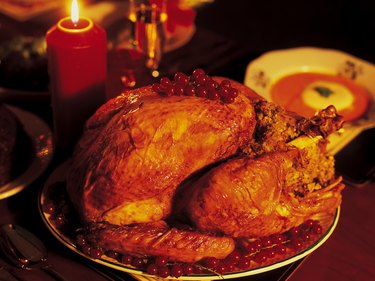
Particularly where the white meat is concerned, turkey struggles to assert its own flavor and can come across as rather bland. However, the size and sturdiness of the average bird allows cooks to exploit the cavity and wrestle with the skin, increasing the opportunities for seasoning.
Conventional Herbs
Video of the Day
Traditionally, sage has the closest affinity with turkey as the basis for an herb stuffing. Comprising mostly breadcrumb and onion, but possibly ground pork, the stuffing can be prepared separately or inserted into the main cavity and neck. If including meat in the stuffing, it should be precooked. Otherwise, the turkey can be rubbed inside and out with a variety of herbs, such as parsley, thyme, rosemary and oregano. To make a wetter rub, mix the dried herbs with lemon juice and olive oil, which will also help the skin crispen as the turkey roasts.
Dry Rubs
Because of turkey's relatively neutral flavor, practically nothing is off the table when it comes to a spice rub. Whatever the spice blend, though, try to use homemade, freshly ground spices rather than store-bought powders. The difference in aroma can be astounding. Salt and pepper come as standard for all rubs, but cumin and chili powder, with a dash of lime juice, will add a pleasant heat to the skin. Likewise, a Chinese five-spice blend of star anise, peppercorns, fennel, cinnamon and clove, with some orange juice for moisture, will infuse the turkey with aroma when rubbed inside the cavity. For smokiness, try including paprika or chipotle powder. Mixing the spices with butter or olive oil also helps integrate the flavor, and will make it easier to work into the cavity meat or beneath the skin.
Cooking Factors
The challenge with a regular oven turkey is not just finding the right spice and herb mix, but also keeping the meat sufficiently moist during cooking to absorb the flavors. Basting provides the conventional solution. The turkey can be marinated overnight in the refrigerator with lemon quarters, crushed garlic and herb bundles in the cavity. Transfer the lemon and herbs to the roasting pan once the bird goes in the oven, adding a cup or 2 of red wine. This liquid, along with the accumulated fat from the cooking turkey, can be used to baste the skin to make it crispy. For deep-fried turkey, more assertive flavors are required, with more focus on the skin. Go for a Cajun-inspired dry rub of paprika, cayenne pepper, thyme and garlic under the skin. Bear in mind that herb stuffing is not suitable for deep-fried turkey as it will not have sufficient time exposed to heat.
Complete Seasoning
Seasoning under the skin allows the spice and herbs to penetrate a meat that is notable more for its texture than natural flavor. The skin covering the breast and thigh is easiest to work free. Sprinkle in the seasoning mixture with a teaspoon, then work it into the meat with your fingers. If applying to the skin, score it first to give the rub some purchase and penetration. Try also brining the turkey with ¼ cup kosher salt for every 4 cups water; along with some acid, such as orange juice or wine; and brown sugar, sage, rosemary and cinnamon. Pat the turkey dry before roasting, however. Rubbing salt in the cavity and on the skin and herbs beneath the skin gives a dry brine. A turkey seasoned this way can be sealed in a plastic bag and refrigerated for 2 to 3 days before cooking.
Check out this related video from ExpertVillage on Youtube
- Butterball: Cooking a Turkey with Stuffing
- Delia Online: Traditional Roast Turkey with Pork, Sage and Onion Stuffing
- The Kitchn: Season Under the Skin
- Splendid Table: Wine and Herb-Basted Roast Turkey with White Wine Pan Gravy
- The Spice House: Turkey Seasoning Favorites
- Fine Cooking: Fresh Herb and Salt-Rubbed Roasted Turkey
- Bon Appetit: Salt-Roasted Turkey with Lemon and Oregano
- Cook’s Thesaurus: Herbs